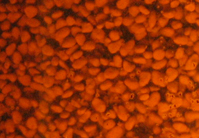Nitrification
Our nitrification process was originally developed for ammonia removal from activated sludge final effluent. However, it has since been applied to sludge liquor ("reject water", "centrate" or "filtrate") treatment. It is also suitable for nitrification of potable water sources (e.g. surface or ground water) prior to chlorination, to reduce the formation of chloramines.
Tertiary nitrification [ 206kb, PDF ]
- Ammonia removal down to 1 mg/L
- Energy consumption reduced by at least 30%
- Nitrification rate up to 2.3 kg NH3-N m3 d-1
- SS reduced by up to 50%
- cBOD reduced by up to 60%
- coliforms reduced by up to 80%
Our tertiary nitrification process is able to reduce the ammonia concentration to 1 mg/L without the rate of nitrification being affected. This is because the expanded bed process is pseudo-plug flow and the concentration at the base of the bed is up to 15 mg/L higher than at the top, where the treated water overflows. Therefore, most of the nitrifying biomass is exposed to an ammonia concentration that is above the rate-limiting concentration for these specialised bacteria. This means that even the most stringent environmental agency discharge consents can be met. And met in a process that consumes at least 30% less energy than competing processes.
Expanded bed technology also allows us to achieve a high nitrification rate, largely because of the large surface area of highly active biofilm and the excellent mixing and mass transfer characteristics of expanded beds. For the nitrification of activated sludge final effluent, we can oxidise up to 2.3 kg NH3-N per m3 expanded bed per day. This is over 4 times the rate of a modern BAFF plant treating the same effluent at the works. Furthermore, the influent to this works is known to contain nitrification inhibitors from industrial sources (Payraudeau, M., Pearce, A. R., Goldsmith, R., Bigot, B. & Wicquart, F. (2001) Experience with an up-flow biological aerated filter (BAF) for tertiary treatment: from pilot trials to full scale implementation. Water Science And Technology, 44, 63-68.). Therefore, we can expect even higher rates at sites without nitrification inhibitors in their influent.
Although designed for tertiary nitrification, our process technology supports other biological activities. For example,
- heterotrophic bacteria grow on the residual cBOD in the activated sludge final effluent;
- protozoa and rotifers feed on the heterotrophic bacteria that grow and on the residual SS in the activated sludge final effluent; and
- oligochaete and nematode worms feed on the bacteria, protozoa and rotifers;
- in this way, SS and cBOD levels can be reduced further and the process can even be operated for zero sludge production.
Because the use of our technology results in such a high rate of treatment, expanded bed plants are compact. Furthermore, because the technology is so simple, they require less operational and maintenance attention. So, if you would like a highly effective, energy-efficient, compact and simple nitrification plant, please contact us!
Sludge liquor (reject water) treatment [ 206kb, PDF ]
- 97% removal of ammonia
- Energy consumption reduced by at least 30%
- Nitrification rate up to 3.5 kg NH3-N m3 d-1
- SS removed
- cBOD removed
- coliforms removed
Our original tertiary nitrification process was switched to sludge liquor (reject water) treatment in 2003 After a short adaptation period, during which the population of nitrifying bacteria increaaed and the biofilms turned visible orange-brown, the rate increased to 3.5 kg NH3-N per m3 expanded bed per day. This was because the process was now under pH control and therefore could be operated at the optimum pH, which is not possible for tertiary nitrification because of cost constraints. Furthermore, because the feed rate was lower, the temperature was closer to the optimum because of mechanical heat from the fluidizing pump.
Although the sludge liquor was obtained from filter presses, it was still visibly turbid. However, the effluent from the expanded bed was visible clear. The suspended solids having been removed by the small population of protozoa that was also present in the biofilms.
Bioethanol production
Because the price of bioethanol is largely dependant on the feedstock cost, it is important to reduce all other costs to a minimum. One of the major fixed costs is the bioreactor and its operation. Using expanded bed technology leads to a variety of advantages:
- 25-40 kg ethanol per m3 expanded bed per hour at 70 g/L concentration
- compact plant; small footprint
- simple, robust, reliable technology
- low capex
- low opex
We immobilize the ethanol-producing microbes on small particles of porous carbon. The small size of these particles provides an enormous surface area for the attached cells, typically 1,800 m2 per m3 of expanded bed. This results in a high biomass concentration, an intensified process and a compact plant. Typically, we can achieve 30-40 kg biomass per m3 of expanded bed, which is at least 10-times the concentration that can be achieved with continuous processes using suspended cells. Therefore, plant size is one tenth that of a conventional process or productivity is ten fold higher.
Reference
M.J. Dempsey, G.M. Black and B. Atkinson (1986). Natural Immobilization of Adhesive Microorganisms in a Solid Support, Fluidized Bed Fermenter for the Continuous Production of Ethanol, pp 246-252. In: B. Atkinson, G.M. Black and C. Webb (eds.) Process Engineering Aspects of Immobilized Cell Systems. Inst. Chemical Engineers, Rugby.
